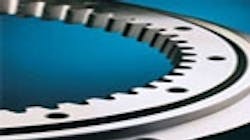Gearing up your bearings
Slewing ring bearings — the bearings that find use on cranes, wind turbines, and other smaller designs — are sometimes cut with teeth to double as gears. Let’s review the benefits and challenges of applying these units.
Drive systems can be simplified by incorporating a gear on either the inner or outer bearing race of a slewing ring. These gear details can take on many styles and features: Fellows stubs, full-depth involutes, straight, helical, hardened or unhardened, and ground or unground, but what factors make for a good slewing-ring gear? Gear static strength, resistance to pitting, gear fatigue, and gear/pinion interfaces, or mesh.
A pressure angle of 20° is most common because 20° cutters are standard, but 14.5°, 25°, and special pressure angles are also used. Machine designers select slewing ring bearings based on load capacities. (See attached load charts.) The tooth size and form is then selected using the following Lewis equation:
L = SFY P Where L = Tangential tooth load
S = Allowable bending stress Y = Tooth form factor (from tables )
P = Diametral pitch F = Face width
The stub tooth form is often used in large gears; economics is the main reason. The form requires less material in the ring forging and less gear cutting time. Full depth tooth forms, on the other hand, provide greater contact ratio for smoother operation, but have lower bending strength.
With core hardness of 23 to 30 Rc, allowable bending stress is 34,000 psi. With 262 to 302 BHN (27 to 32 Rc) this is 37,000 psi, and 29 to 34 Rc allows 40,000 psi. These stress approximations are for maximum or stall torque conditions — so when shock is included in the loading, higher stresses may occur.
Induction-hardened gear teeth with a minimum surface hardness of 55 Rc should be considered when high tooth surface pressures are constant. One example is an excavator or logger that undergoes high acceleration rates and rapid deceleration during a swing cycle.
A full root radius with root hardening is also recommended; the tooth pattern and depth of hardness are critical here.
Backlash
All gears need backlash room. This is especially true of bearing gears, in which large diameters and large center distances require greater manufacturing tolerances. Other factors can determine whether adjusting the center distance between gear and pinion is appropriate to make room for backlash. The cost advantages of adjustment should be kept in mind: Gear size tolerance can be greater (and life extended) with takeup for wear.
Installation
Installation of bearing/gear assemblies should be done in a clean, dry, well-lit area. Housing mounting surfaces and pilots should be unpainted and wiped clean of chips, dirt, and lint, because even soft materials make high spots when entrapped. Any weld spatter, nicks, and burrs should be removed.
The bearing can be lifted or hoisted into position using eye bolts in mounting holes (or nonmetallic slings) which can prevent damage to bearing surfaces and gear teeth.
Inherent to the hardening process of most turntable bearings is a small gap at one point in the raceway; loading holes are drilled through this gap. These gaps (and load hole plugs, in races with through holes) should be positioned at minimum load points if possible. Load hole plugs in races with tapped holes or weld rings must be so positioned. With the rotating race, this is done by placing the loading hole 90° off the maximum load zone from moment loading. With the stationary race, this position depends upon the location of the lightest load relative to the lower structure of the machine.
For good internal load distribution and smooth, low-torque operation, the bearing should be as round as possible when the bolts are tightened. If one race is doweled or piloted, it should be mounted first when possible.
On unpiloted gear bearings the gear/pinion backlash should be checked and adjusted. The minimum backlash point of the gear is often identified by yellow paint in the tooth space. When installing:
- Leave all mounting bolts loose until both mating parts are attached to the bearing.
- While applying a moderate centered thrust load to the bearing, measure the torque to rotate the bearing. Then tighten all bolts to the level prescribed by the bolt manufacturer. This is very important; improperly tightened bolts can fail due to fatigue and can harm equipment and workers.
- Again measure the torque required to rotate the bearing. If greater than the first measurement, the bearing is being distorted. Determineand correct the cause.
After these steps, gears on fixed centers can be checked for backlash, and pinions on adjustable centers set for proper backlash.
When all backlash checks are completed, the gear should be coated with grease suitable for the operating conditions, and rotated to ensure coverage of all contacting surfaces with the pinions.
Complete installation of all rotating components of significant weight, and check bearing for freedom of rotation. Again, excessive torque or variations are indicative of an unsatisfactory installation condition.
Beyond backhoes: Small designs
Significant changes are taking place in the use of slewing ring bearings. The traditional perception of slewing ring bearings as large-diameter, heavysection, low-precision bearings with bolt holes and gears for construction equipment applications is no longer valid; these bearings are increasingly used in smaller, precise applications.
Improved manufacturing methods and design concepts are behind this trend. Smaller, off-the-shelf slewing ring bearings (preloaded to eliminate clearance and improve stiffness) have become standard in the machine tool industry; runout and diameter tolerances for these bearings can be specified in ten-thousandths of an inch, vs. thousandths.
The design is useful in even small designs because it’s simple to bolt a rotating structure to a stationary base.
